 Station at Saint Paul-without-the-Walls
Station at Saint Paul-without-the-WallsAt Rome the Station was held at the
great basilica of St Paul's on the Via Ostia outside the walls of the City, built over the tomb of the Apostle to the Gentiles by the emperor Constantine in 324. It was almost wholly destroyed by fire in 1823 but it was rebuilt and consecrated in 1854. To my mind, it is the most beautiful and serene of the four papal basilicas in Rome and a fitting monument to my baptismal name-saint. On this day in the Roman Church, the second Great Scrutiny for catechumens was held, when candidates for admission to baptism were examined, hence a large church was needed for this Station. The choice of so great an apostle and fisher of men, is entirely apt and felicitous.
Considering the fact that many people call St Paul the first Christian theologian, I would like today to draw our attention to a theologian who, like St Paul, consistently preaches the love of God in Christ Crucified and who is a key figure in the renewal of Catholic theology in our day when so much of contemporary theology has become an academic exercise - often devoid of prayerful contemplation and thus soul-less.
To my delight, a friend of mine in Canada and my brother novice both expressed very recently a growing interest and love for
the writing and ideas of Hans Urs von Balthasar (1905 - 1988). This great theologian is one I have been discovering for a good number of years now, one whose ideas challenge and attract me by their sheer beauty and profundity as well as the stark radiance of the Cross. I began with '
A Short Primer for Unsettled Laymen' and little did I imagine that this little book would be the first steps on my theological journey with such an accomplished and fascinating guide.
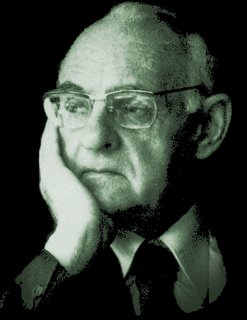
I have known seminarians who dismiss Balthasar because of a
perceived flirtation with 'universalism', lecturers who are experts in Rahner but fail to read
any of Balthasar's corpus of writings and others who denounce him as an ivory-towered aristocratic dogmatician and thus lackinng in 'relevance'. And yet, Balthasar is and remains one of the last century's most fascinating and
prolific theologians, even the greatest 20th-century Catholic theologian. Reputedly Pope John Paul the Great's "
favourite theologian" and also
beloved of Pope Benedict XVI, I think there is a
growing surge of interest in Balthasar, especially as more and more of his many writings are being translated from German into English, thanks to the wonderful
Ignatius Press. Reading the late Holy Father's encyclicals and as I read
Deus Caritas Est, I could not help but notice the glimmer of Balthasarian influence on the writings of these pontiffs.
Only last October, on the occasion of Balthasar's birth centenary, Pope Benedict said of him: "
I think that his theological reflection maintains intact, to this day, a profound timeliness and leads many to penetrate ever more in the profundity of the mystery of faith, held by the hand of such an authoritative guide... The example that von Balthasar has left us is rather that of an authentic theologian who had discovered in contemplation the coherent action in favor of Christian witness in the world. In this significant circumstance, we remember him as a man of faith, a priest who in obedience and hiddenness, never sought personal affirmation, but full of the Ignatian spirit always desired the greater glory of God."
But many people may feel intimidated by such a giant of theology. And yet, his writings are not inaccessible, despite their poetic and mystical style. The
Balthasarian Trilogy on the theological aesthetics is a huge amount of theology to digest and presupposes a sound grasp of philosophy and Western culture; but one need not start here, or even necessarily look into it. Balthasar himself said that "
the aesthetics is a fragment among other fragments... Perhaps the shorter books provide a better view of the whole than this meandering work".

So as we approach Passiontide, my mind often turns to Balthasar's shorter but magnificent work, '
Mysterium Paschale', which is, in my opinion, one of the most profound reflections on the kenosis of Christ, the depths of the love of God revealed on the Cross and
the meaning of Holy Saturday. Dr Andrew Louth has called this book "
a concise introduction to the very heart of Balthasar's theological vision."
Cynthia Neilsen has blogged on this book if you want a taste of it and hopefully, you will want to obtain a copy to read yourself.
In addition, I would recommend articles in
Communio, the international theological review founded by Balthasar with Ratzinger and De Lubac. In its
current issue, there is an
article by Adrian J. Walker which I would highly recommend, especially if one is interested in beginning a relationship with Balthasar's theology. It is
available online and it is called '
Love Alone: Hans Urs von Balthasar as a Master of Theological Renewal'. Below is an excerpt from this article which contextualizes Balthasar and his way of approaching theology and situates him within the school of John Paul II and Benedict XVI, leading to the much-needed renewal of Catholic theology and theologians:
"Contrarily to what it may seem at first, then, the crisis of Catholic theology today boils down to a conflict between two and only two possible first principles: experience or divine revelation. Or, to be more precise: between the logos of what John Milbank calls “secular reason” or the logos contained in divine revelation itself. This contest, it is important to see, is an unequal one. Of the two alternative principles, in fact, divine revelation has the greater integrative power: it can comprehend all that is true in “secular reason,” whereas the converse is far from being the case. Recognizing this poverty of mainstream liberal theology, with its captivity to the secular social sciences as the oracles of all-judging experience, a growing number of voices on the English-speaking Catholic theological scene have begun to call for what William L. Portier has felicitously termed the “re-theologization of theology.” These theologians have found confirmation and support in the pontificates of John Paul II and Benedict XVI, who, contrarily to the stale clichés propagated endlessly by the media, have not been conservative “restorationists,” but faithful expositors of Vatican II’s attempt to reawaken in the Church a living awareness of its all-embracing catholicity—not on the basis of liberal cosmopolitanism, but on the basis of Christ who, in revealing the Father, also reveals man to himself (see Gaudium et spes, 22)...
A re-theologized theology, if it is to measure up to the Christian tradition it claims to recover, must go beyond the opposition between Christian uniqueness and universal relevance that both liberal and post-liberal theology assume, in order to re-learn that the distinctive principle of theology is itself what is most universally relevant, “so that holy teaching,” as Aquinas puts it, “is a sort of impression of the divine knowledge, which embraces all things in its simple oneness.”
With that we come to Hans Urs von Balthasar, whom I would like to propose in the following pages as a master of theological renewal able to teach us how to re-theologize theology without sacrificing its hallmark claim to speak to universal human reason. To be sure, Balthasar clearly distinguishes himself from most other contemporary Catholic theologians by the radical consistency of his commitment to starting theology from, and letting it be normed by, the uniquely Christian revelation of God’s trinitarian love in Christ."
Read the rest here and click
here for more Balthasar articles online.
May St Paul pray for us on our journey into the heart of Christ, the mystery of the Cross.
 The Station is at the 'Dominicum Eusebii', erected on the site of the house where St Eusebius of Vercelli, a 4th century bishop and an ardent defender of the faith against Arius, died a martyr c.357. It is situated on the Esquiline hill near the great cemetery of the Via Merulana and as the titulus Eusebii is one of Rome's ancient parish churches. In the 18th century the Irish Augustinians occupied the priory and basilica. This title is given to a cardinal priest and is currently vacant.
The Station is at the 'Dominicum Eusebii', erected on the site of the house where St Eusebius of Vercelli, a 4th century bishop and an ardent defender of the faith against Arius, died a martyr c.357. It is situated on the Esquiline hill near the great cemetery of the Via Merulana and as the titulus Eusebii is one of Rome's ancient parish churches. In the 18th century the Irish Augustinians occupied the priory and basilica. This title is given to a cardinal priest and is currently vacant.


















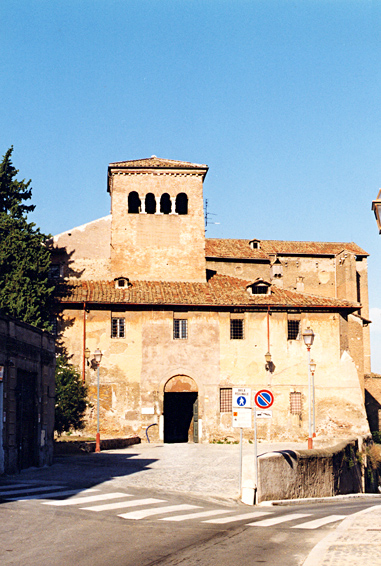
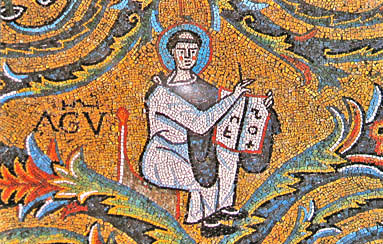 From this point of view 'church' is a verb rather than a noun. 'Church' refers to the work of reconciliation between men. This suggests how our religious communities within the Church are meant to function. They have a never-ending task of becoming truly one, of reducing multiplicity to a unity which stifles no one but opens up to us a share in the unity of the Father and the Son, what we call the Holy Spirit.
From this point of view 'church' is a verb rather than a noun. 'Church' refers to the work of reconciliation between men. This suggests how our religious communities within the Church are meant to function. They have a never-ending task of becoming truly one, of reducing multiplicity to a unity which stifles no one but opens up to us a share in the unity of the Father and the Son, what we call the Holy Spirit. 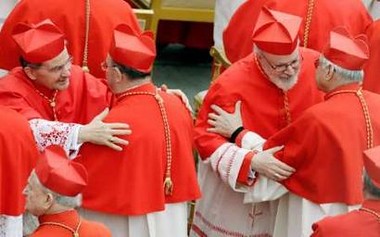


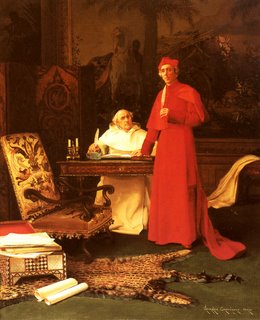

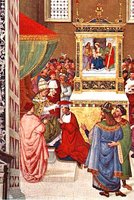

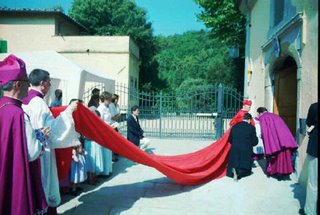
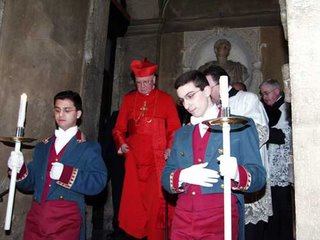

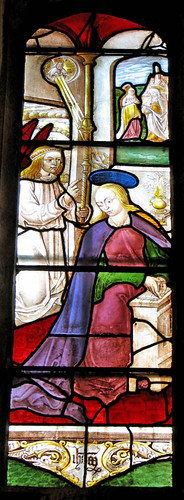

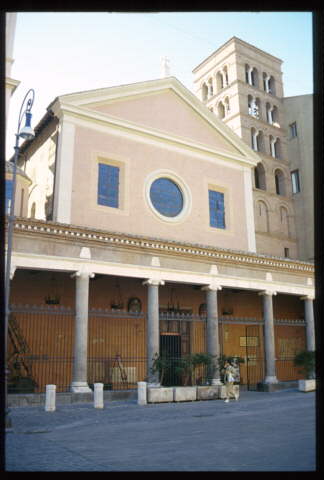
 Today, the eve of the Annunciation, the Holy Father will hold a public consistory and
Today, the eve of the Annunciation, the Holy Father will hold a public consistory and 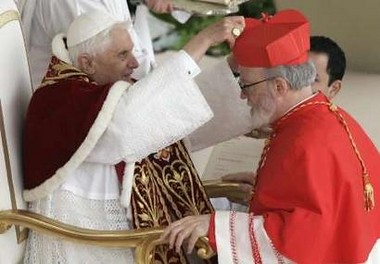



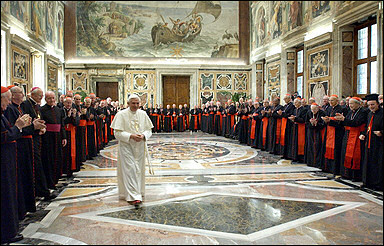 The two-word name 'Roman Catholic' expresses no contradiction, as though the name of a particular church, a city, were a restricting or even a withdrawing of catholicity. Rome means fidelity to the origins, to the Church of all ages, and to a Church which speaks in all tongues. But for Rome to have such a spiritual content means for us, who are called to be this Rome today, the guarantee of genuine catholicity and an obligation that demands much of us.
The two-word name 'Roman Catholic' expresses no contradiction, as though the name of a particular church, a city, were a restricting or even a withdrawing of catholicity. Rome means fidelity to the origins, to the Church of all ages, and to a Church which speaks in all tongues. But for Rome to have such a spiritual content means for us, who are called to be this Rome today, the guarantee of genuine catholicity and an obligation that demands much of us.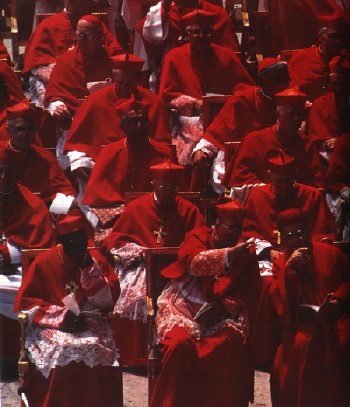



 Fr
Fr 

 We for our part can hope to find there the power for our smaller purposes. It is not much use setting out to execute grandiose schemes of asceticism of our own choosing if at the same time we grumble at every little trial that God sends us. The first thing we can learn from the attempt to cast all our cares upon him is the ability to see his love in all that comes to us and so to accept it lovingly and if possible gladly. The gladness, we know, would be there if only our sense of God's providence and love of God's providence were deeper and stronger. The essential thing therefore is to try to make sure that we are going in the right direction, taking things in their right order: first the deepening awareness of our total dependence on God, then the correspondingly deep awareness of his constant care for us and the joy of being in his house, then thirdly the response which is thus called forth from us, the deepened gratitude for, and love of, that will in which his care is expressed at each moment as it comes, and so finally the ability to make of each moment a sacrifice of praise, something that we take humbly and gladly from the hands of God and, having done the best we can with it, return to those hands. Then in that setting we can hope that any sacrifices we try to make in addition to what comes to us not of our choosing will similarly be sacrifices of praise, similarly theocentric, similarly motivated and ensouled by love. And so we come back to the beginning: because if they are indeed acts of love they will certainly also be acts of joy."
We for our part can hope to find there the power for our smaller purposes. It is not much use setting out to execute grandiose schemes of asceticism of our own choosing if at the same time we grumble at every little trial that God sends us. The first thing we can learn from the attempt to cast all our cares upon him is the ability to see his love in all that comes to us and so to accept it lovingly and if possible gladly. The gladness, we know, would be there if only our sense of God's providence and love of God's providence were deeper and stronger. The essential thing therefore is to try to make sure that we are going in the right direction, taking things in their right order: first the deepening awareness of our total dependence on God, then the correspondingly deep awareness of his constant care for us and the joy of being in his house, then thirdly the response which is thus called forth from us, the deepened gratitude for, and love of, that will in which his care is expressed at each moment as it comes, and so finally the ability to make of each moment a sacrifice of praise, something that we take humbly and gladly from the hands of God and, having done the best we can with it, return to those hands. Then in that setting we can hope that any sacrifices we try to make in addition to what comes to us not of our choosing will similarly be sacrifices of praise, similarly theocentric, similarly motivated and ensouled by love. And so we come back to the beginning: because if they are indeed acts of love they will certainly also be acts of joy."